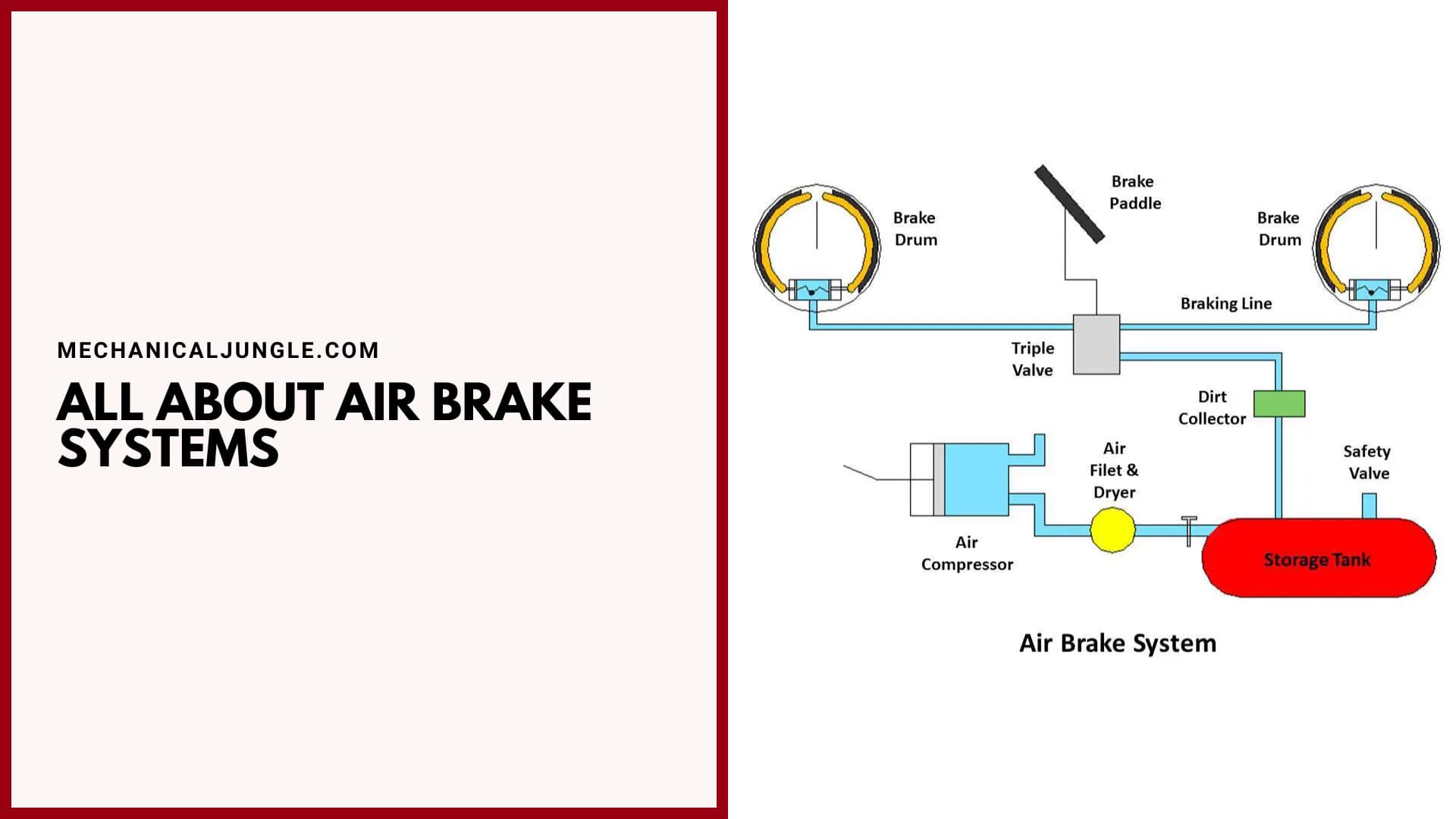
What Is Air Brake Systems?
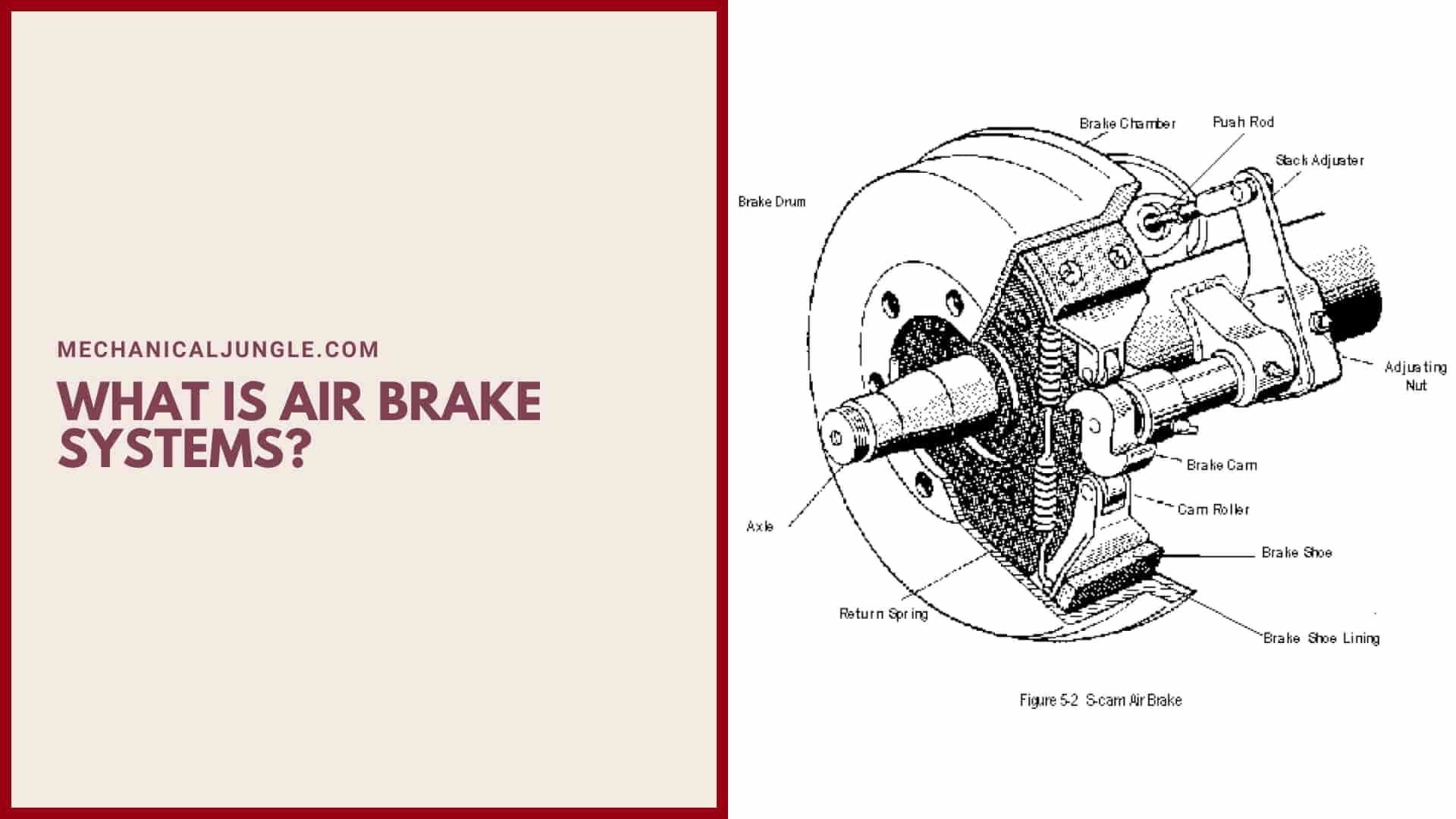
Air brake systems are commonly used in heavy commercial vehicles and trucks. They require a heavy braking effort that can be applied by the driver’s leg alone.
You apply compressed air pressure to operate the air brake instead of just the foot pressure acting against the flexible diaphragm in the brake chamber. Today we will learn about the air brake system. The air braking system is a high-power braking system.
It is commonly used on heavy vehicles, such as trucks, buses, etc. In my previous posts, we have discussed several types of brakes, and we know that there are only two types of braking systems.
The first one is known as the disc brake, and the second one is the drum brake. These brakes are driven by humans or some other power source.
According to the power source, these brakes can be classified into other types such as hydraulic brakes, air brakes, vacuum brakes, etc. When driving a heavy load vehicle, it is impossible for humans to generate braking force.
So another power system is used to generate the braking force that forces the braking pad and produces a frictional force between the brake and the tire that goes to stop the vehicle.
The air brake system uses air to generate this force. This type of braking is similar to hydraulic brakes, requiring that these brakes use compressed air to apply brakes instead of hydraulic pressure.
This is the basic concept of any power brake system. Now we discussed how this system uses air to generate braking force.
A pneumatic brake or compressed air brake system is the type of brake system in which the compressed fluid from the hydraulic system is replaced by compressed air to pressurize the piston of the master cylinder, which in turn stops to pressurize the brake pad or vehicle.
Working of Air Brake Systems:
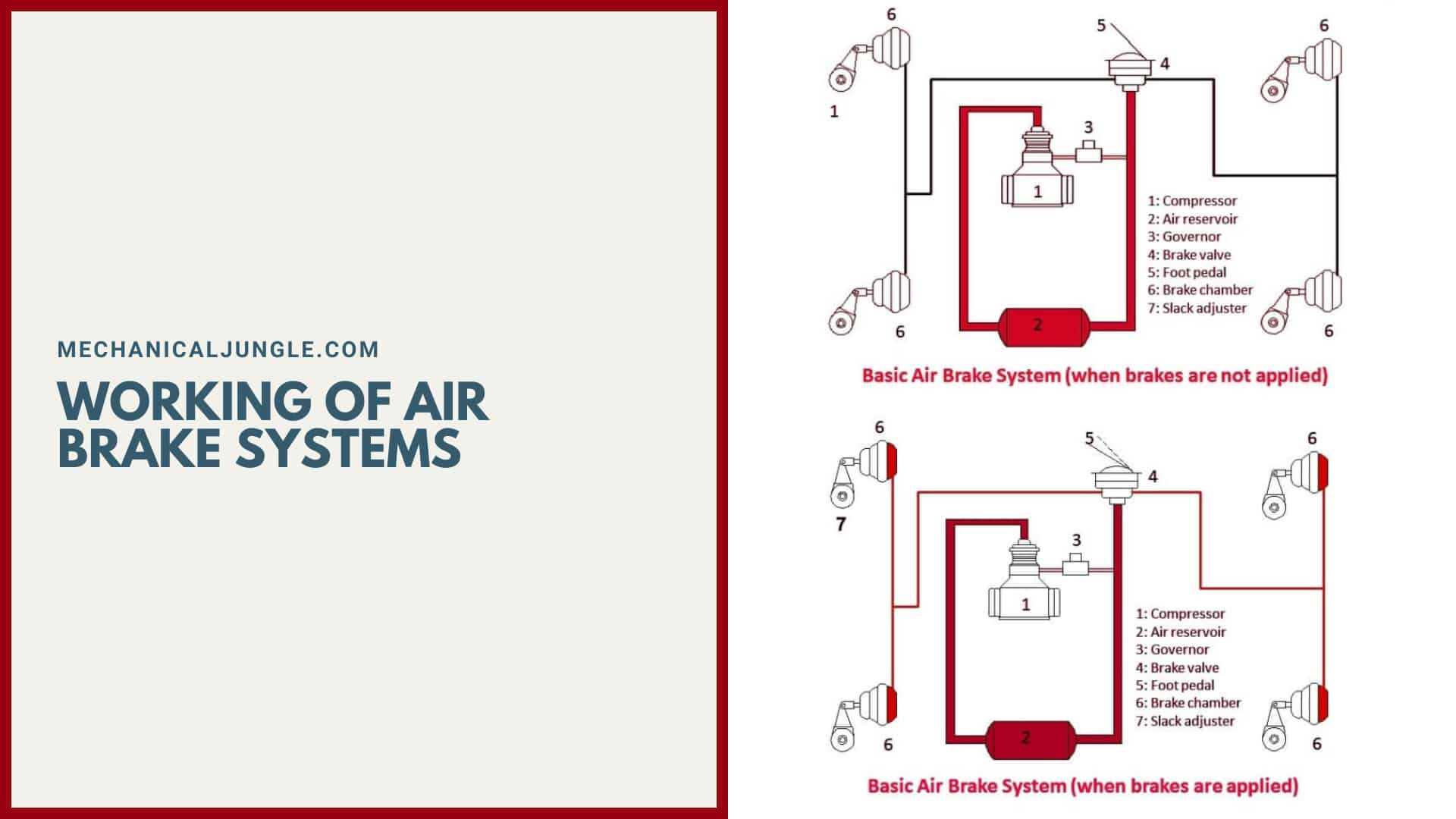
When the brake pedals are pressed, the exhaust passage closes, and the air intake route opens, and the compressed air moves back into the chamber. During the return stroke, the exhaust passage opens while the intake is closed and the air used goes into the atmosphere.
The system is equipped with an emergency mechanical brake, which can be used when the air supply fails the air brake system, known as the air-assisted hydraulic braking system.
When the driver of the vehicle presses the brake pedal to stop or stop the vehicle, the following procedures take place – When the driver starts the engine, the brake compressor starts because it is powered by the engine, which in turn starts compressing atmospheric air and the compressed air is sent to the compressed air reservoir with this optimal air through the compressor governor Which always contains some amount of air stored from the previous cycle.
With this friction contact between the brake pads and the rotation, drum line brakes are applied to the wheels to stop or stop the vehicle.
When the driver presses the brake pedals, the outlet valve of the triple valves closes, and the inlet valve opens, which in turn passes the compressed air from the reservoir to pass through the brake lines of the system.
These compressed-air flowings through the brake lines are then transferred to the brake cylinder, which has a piston inside it.
When compressed air pressurizes the piston inside the brake chamber, the piston moves away from its original position, which converts this pneumatic energy into mechanical energy.
At the wheel end of the brake cylinder, brake drums are placed inside, which is a housing of mechanical actuators such as springs or slacks with brake pads at the outer end.
Due to the piston speed due to the pressure applied by the compressed air, the mechanical actuator inside the brake drum expands, which pushes the brake pads in an outward direction to create frictionless contact with the rotating drum lines.
Part of Air Brake Systems:
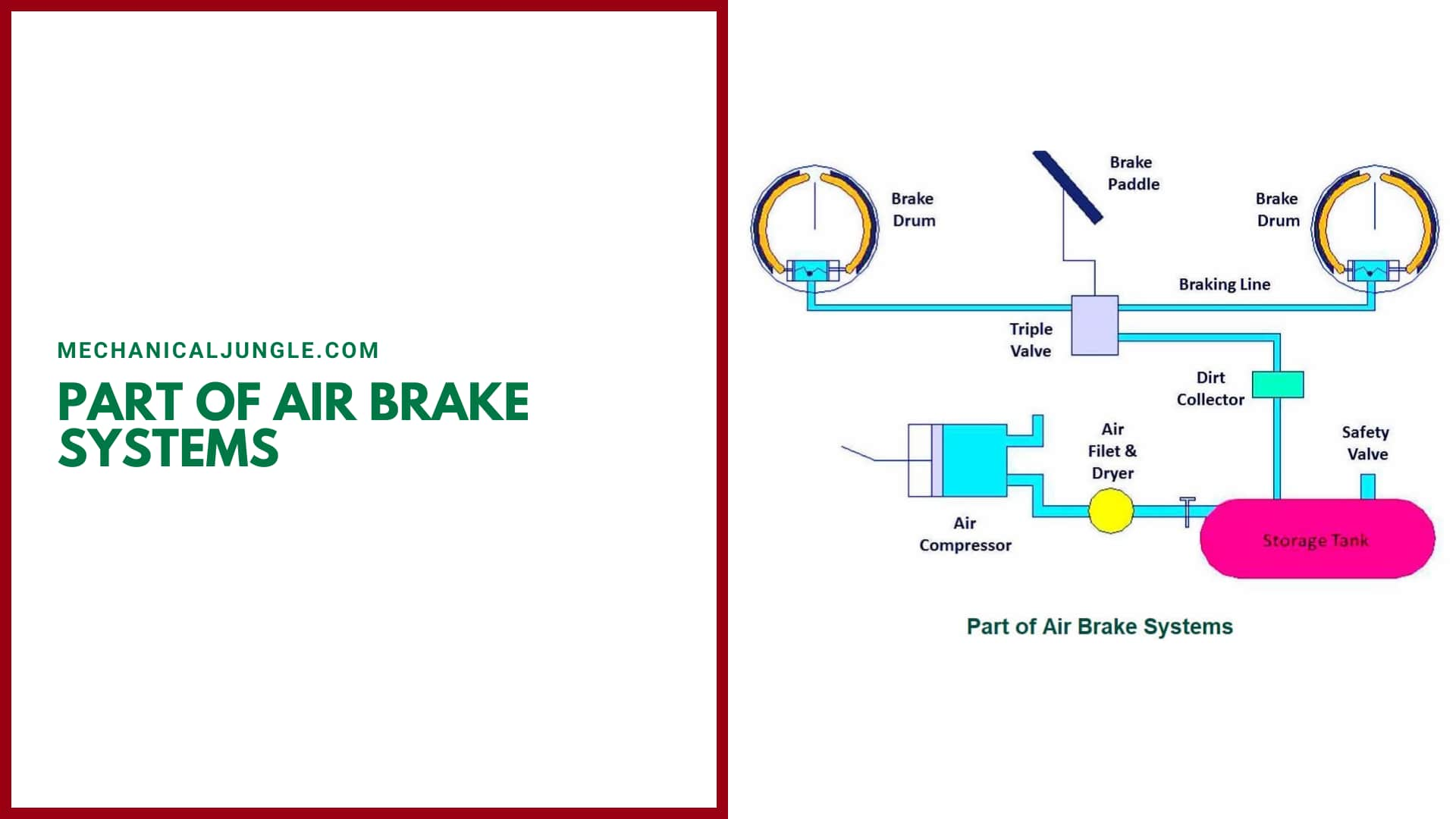
#1. Air Compressor
The air compressor is the main part of any air brake system that is driven by the engine using a belt drive. It compresses atmospheric air to the desired pressure and transfers it to the storage tank.
#2. Storage Tank
It stores compressed atmospheric air at high pressure. Also, an essential part of the air brake systems as compressed air is responsible for the entire operation.
The brakes can be applied several times while the automobile is running, so the compressor is not capable of performing these tasks alone, which requires aerial storage.
#3. Brake Pedal
The brake pedal is an input to the brake mechanisms. It is operated by the drivers inside the automobiles. The brake pedal is a type of mechanical linkage that transfers the input motion to the forward mechanism and initiates the brake application.
#4. Brake Actuator
A brake actuator is a piston-cylinder arrangement that is directly connected with the brake pedal. When the brake pedals are pressed, it creates pressure throughout the assembly.
#5. Safety Valve
The safety valve is a safety component that attaches to the air storage tank. This prevents the bursting of the tank due to excessive pressure because the air compressor works continuously and supplies the compressed air in the tank.
Air is released by the safety valves when the air pressure reaches certain values.
#6. Dirt Collector
A dirt collector is a small device used before the triplet valve. It is used to collect dirt particles separated by air filters.
#7. Brake Drum
The brake drum is the part that performs the brake. This is the last part of the brake assembly. It is mounted on automobile tires.
#8. Braking Lines
Braking lines are also known as supply lines. The transfers of compressed air from the reservoir to the brake drum are done by simply breaking the lines.
#9. Triple Valve
The triple brake is responsible for the entire operation of the air brake. Applying and releasing the brakes requires a continuously applied and releasing mechanism that is performed by the triple valve.
When the brake pedals are pressed, it applies pressure while it releases the pressure immediately when the pedal is released.
#10. Air Filter and Dryer
Air filters and dryers are the two major components that are used before entering the air compressor. As the name suggests, air filters are used to remove dust mites from atmospheric air, while a dryer inlet removes moisture and humidity from the air.
It is necessary that only dry air enter the air compressor because the moisture content will cause the failure of the braking system due to the condensation of water particles.
Construction of Air Brakes Systems:

Air brake systems consist of a two-stage air compressor powered by a crankshaft or gearbox shafts. It takes air from the atmosphere, compressed it, & sends it to the air reservoir through an un-loader valve. Where the reservoir pressure reaches the maximum degree, the unloader valve opens.
The compressed air is then directed directly into the atmosphere. Each of the four wheels fitted with brake chambers has a diaphragm, and air pressure is applied and pushed.
This force operates the cam actuating lever and applies the brakes. Each of the brake chambers is attached to the brake pedal, and the air filter is also fitted between the brake valve and the reservoir.
Working Principle of Air Brakes Systems:
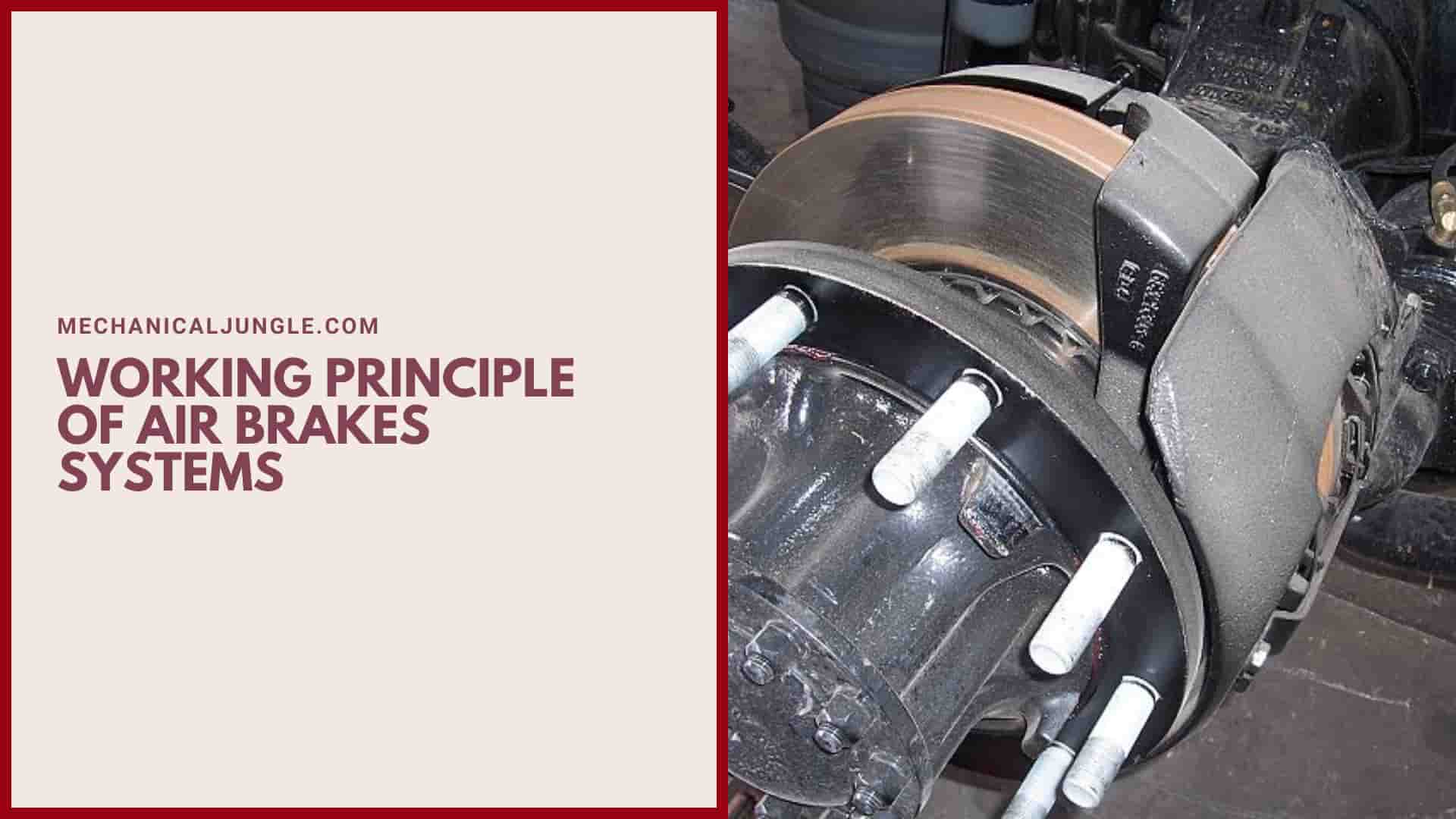
As shown in the figure, compressed air (about 700 kPa) is used in the air brake to activate the brake mechanism. The figure shows the complete layout of the air brake systems. It consists of an air filter, unloading valve, air compressor, air reservoir, brake valve, and 4 number brake chamber.
The compressors take atmospheric air through the air filter & compress the air. This air is stored under pressure in air reservoirs. From this reservoir, air travels to the various goods of the vehicle, which operate on compressed air.
A portion of the air goes into the brake valve. The brake valve is controlled by a driver who controls the intensities of braking according to an emergency.
Pedal Depressed:- When the brake pedals are depressed, compressed air from a reservoir is transmitted uniformly in all directions to the brake chambers through the brake valve through a pipe that applies the brake.
Pedal Released:- When the drivers release the brake pedals, the master cylinder returns to its original position due to the piston return spring, and the pressure is dropped. It releases brake shoes from the brake drum: the original position and the brakes are released.
Advantages of Air Braking Systems:
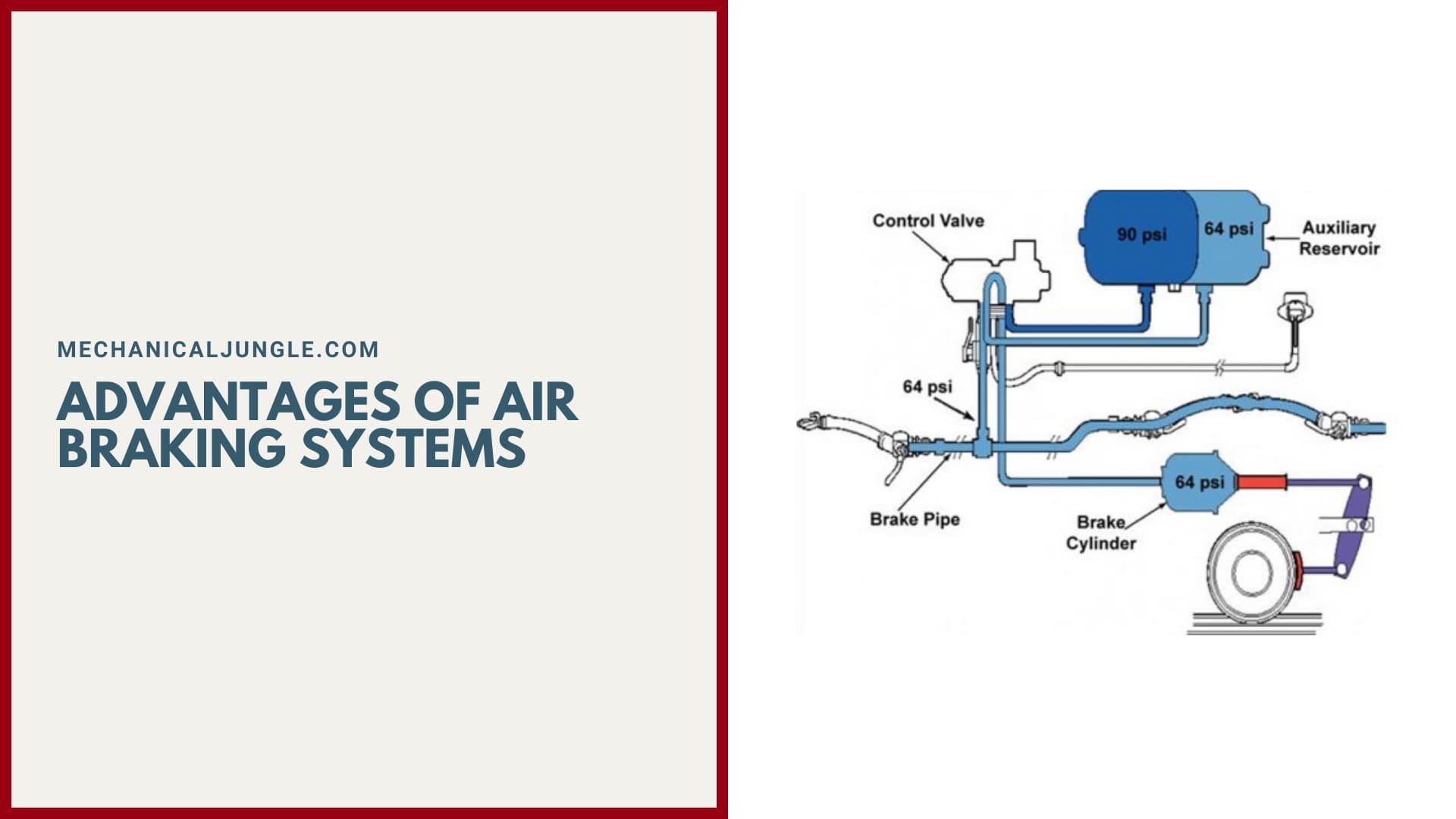
Here, the different advantages of air braking systems are as follows
- It is more effective than other brakes.
- The air brake parts are conveniently located where the chassis design is simple to make.
- Compressed air can be used for tire inflation wipers, horns, and other accessories.
- It employs only air as a working medium that is readily available.
- It is used in railways.
- Today, all the trucks and buses on the road, some of them use air brake systems.
- It is easy to store air at highs pressures.
- It provides heavy braking effects used in heavy vehicles & trucks.
- This provides better control.
- This reduces the stopping distance.
- This mainly allows for less wear and tear of parts.
- It has a flexible hose connection.
Frequently Asked Questions (FAQ)
What Is an Air Brake System?
An air brake system is a high-power braking mechanism used primarily in heavy commercial vehicles such as trucks and buses. It utilizes compressed air to apply the brakes, instead of relying solely on hydraulic pressure or mechanical force.
How Does an Air Brake System Work?
The air brake system operates by compressing atmospheric air using an air compressor, which is then stored in a reservoir. When the driver presses the brake pedal, compressed air is directed through brake lines to brake chambers, causing pistons to push brake pads against the brake drum, thereby creating friction and slowing down the vehicle.
What Are the Main Components of an Air Brake System?
The key components include:
- Air Compressor: Compresses atmospheric air.
- Storage Tank: Stores compressed air.
- Brake Pedal: Input mechanism for the braking action.
- Brake Actuator: Piston-cylinder arrangement that creates pressure.
- Safety Valve: Prevents excessive pressure in the storage tank.
- Dirt Collector: Removes dirt particles from the air.
- Brake Drum: Performs the actual braking action.
- Braking Lines: Transfer compressed air to the brake drum.
- Triple Valve: Manages the application and release of brakes.
- Air Filter and Dryer: Remove dust and moisture from the air.
What Is the Difference Between Air Brakes and Hydraulic Brakes?
Air brakes use compressed air to operate, whereas hydraulic brakes use brake fluid. Air brakes are typically used in heavy vehicles for their effectiveness in generating high braking force, while hydraulic brakes are more common in lighter vehicles.
What Are the Advantages of Air Brake Systems?
Advantages include:
- Greater effectiveness in heavy vehicles.
- Simple chassis design and convenient component placement.
- Ability to use compressed air for other vehicle functions like tire inflation and horns.
- Readily available working medium (air).
- Better control and reduced stopping distances.
- Less wear and tear on parts due to robust design.
What Maintenance Is Required for Air Brake Systems?
Regular maintenance includes checking the air compressor, storage tank, brake lines, and safety valves for leaks or wear. It’s also important to ensure that the air filter and dryer are clean and functioning properly, and to inspect the brake drums and actuators for any signs of damage.
How Can I Tell If There Is a Problem with My Air Brake System?
Signs of problems may include:
- Unusual noises during braking.
- A decrease in braking power or responsiveness.
- Warning lights on the vehicle’s dashboard.
- Leaks in the air lines or storage tank.
- A hard or unresponsive brake pedal.
Why Is It Important to Have an Emergency Brake System in Air Brake Systems?
An emergency mechanical brake system is crucial as a backup if the main air brake system fails. It ensures that the vehicle can still be brought to a stop safely even if there is a loss of air pressure or a failure in the primary braking system.
Can Air Brake Systems Be Used in Other Applications Besides Trucks and Buses?
Yes, air brake systems are also used in railways and some other heavy machinery. Their effectiveness in providing strong and reliable braking force makes them suitable for any application requiring significant stopping power.
How Do Air Brakes Differ from Drum Brakes?
Air brakes refer to the overall braking system that uses compressed air, while drum brakes are a specific type of braking mechanism within the air brake system. Drum brakes use friction between brake shoes and a rotating drum to stop the vehicle.

